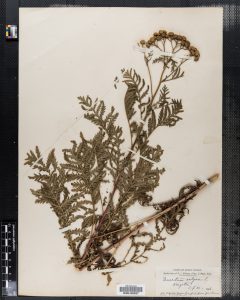By Keith Killingbeck

A KIRI specimen image from the CNH portal, of common tansy (Tanacetum vulgare) collected in Kingston September 30, 1896, by URI’s first professor of botany and first female professor, Harriet L. Merrow.
From the annals of Johnny Carson’s Tonight Show and The Magnificent Carnac, the answer is … KIRI. The question is: What is …
a) a genetically engineered fruit from New Zealand similar to the kiwi?
b) Google’s version of Siri?
c) a new country in Africa just north of Namibia?
d) the official name in Index Herbariorum of the herbarium housed at the University of Rhode Island?
You get three gold stars and free tea at the Survey office on Wednesday afternoon if you who chose d), the official name of the herbarium at the University of Rhode Island.
The derivation of the name is extraordinarily simple – Kingston, Rhode Island. KIRI, one of approximately 3,000 herbaria in the world, is home to plants from 47 states, the District of Columbia, and eight additional countries. Specimens from 193 families, 791 genera, and 2,440 species make up the 12,682 individual pressed vascular plants preserved in the collection (plus hundreds of non-vascular plant specimens).
Two thousand sixteen has been a banner year for KIRI. A partnership between URI and Yale University resulted in the transfer to New Haven, and return to URI, of our entire vascular plant collection. All of the 12,000+ vascular plants in our collection were photographed and digitized over the summer and early fall. The digitized images were then integrated into the website of the Consortium of Northeastern Herbaria, a portal that provides access to the collections of almost all major herbaria in northeastern North America. With funding from the National Science Foundation, Patrick Sweeney and his team from Yale did an incredible job with our collection. This step forward for KIRI could not have happened without their resources and talents.
The Consortium of Northeastern Herbaria web portal is searchable in multiple ways. Information about each herbarium (number of species, genera, families, etc.) can be found through the ‘collections’ section, including the University of Rhode Island KIRI Herbarium profile page. The images of our specimens on the website are organized by taxon and can be displayed beside all other images from northeastern North America for that taxon.
Because the Consortium site is easy to use, costs nothing to enter, and contains a wealth of information that would take eons to retrieve from individual herbaria, it will be a go-to resource for those of us in the Rhode Island Natural History Survey who are smitten by all things green … frogs included, but there are no pressed amphibians in the KIRI cabinets. To make full use of the Consortium of Northeastern Herbaria website, simply start a ‘new account’ from the ‘portal’ page.
By the way, for those of you who may be unfamiliar with Carnac the Magnificent, check out his wikipedia entry or the many YouTube clips that feature the all-knowing soothsayer and sage from days of TV past. Checking this out will not bolster your plant IQ, but it could evoke a smile or two.